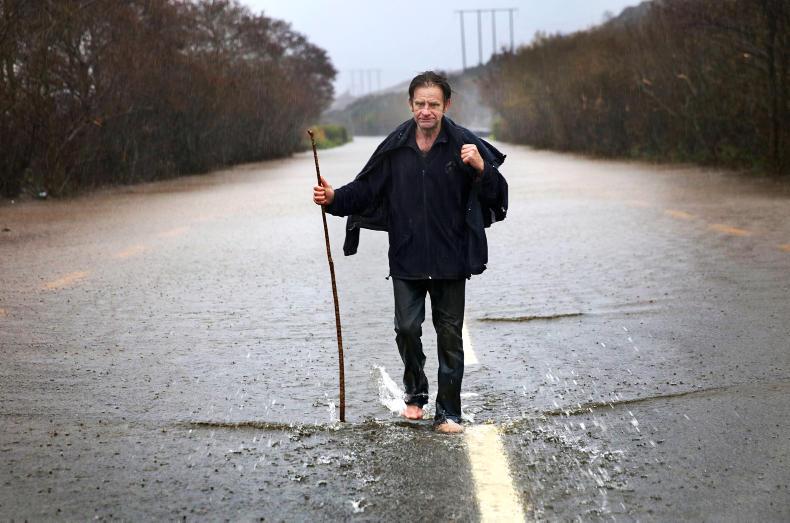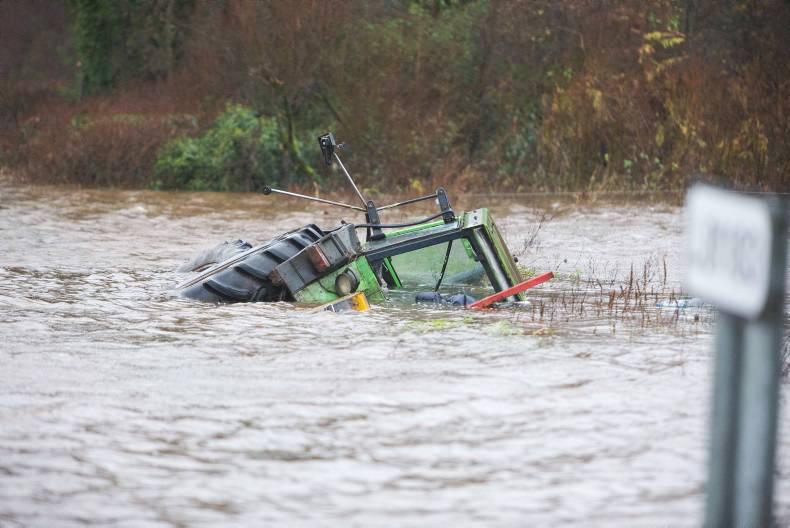Rainfall recorded over the last 10 days has exceeded the norm. Claremorris recorded 132mm of rain, 466% above average. Moving south, Roches Point had almost 90mm of rain, 395% above average. Malin Head weather station reported a similar story with over 120mm of rain.
However, it is predicted that the worst is yet to come. The big rivers are near bursting point and many say it is only a matter of time before the inevitable happens.
“Smaller rivers have already exceeded the levels seen in the 2009 flooding,” said Andrew McHugh, member of the IFA Flood Committee.
“Along the Shannon, systems will get worse over the coming days. In 2009, Lough Ree had the capacity to hold excess water, however the lake is already close to levels seen then. The problem won’t necessarily happen immediately as rain has to filter down through the water systems and into the lake before flooding will occur.”
Some farmers are already dealing with the effects of high water levels.
“We had an advantage this time in the sense that we could warn farmers,” said Tom Turley, IFA flood project chairman.
“Animals were lost in the floods of 2009, we haven’t had any reports of that yet.”
In a meeting between the IFA, Minister for Agriculture, Simon Coveney, and head of the Office of Public Works (OPW), Simon Harris, it was agreed that farmers could move water from flooded slurry tanks in an effort to maintain animal welfare.
“Effectively, we have a derogation for emergency cases,” said Turley. “But this is only for those affected and it is not to be abused. The advice is to use a sludge pump if possible and move water to the driest land available.”

Extreme storms
In recent years, Ireland has witnessed a cluster of extreme stormy seasons, ranging from autumn 2010, summer 2012 and the winters of 2013 and 2014.
According to Dr Connor Murphy, lead researcher at the Climate Analysis and Research Unit, we can expect to see an increase in storm intensity, coupled with increased incidences of flooding.
“When we go back over the long term, we don’t see an increase in frequency but we do see an increase in intensity,” said Murphy, speaking on RTÉ’s Morning Ireland.
“There is uncertainty in some of the old records, but the increase in intensity is what we would expect from climate change.
Cyclone storms like Desmond are associated with flooding. During a cyclone, more than half the rivers in the country can flood and we have seen that this year.
Further widespread rainfall is predicted over the next week, particularly over the weekend. 10mm to 43mm of rain are forecast, with the heavier levels expected in the southeast and southwest.
CFRAM
The OPW is developing plans to deal with flooding in the future through the Catchment Flood Risk Assessment and Management (CFRAM) programme.
Currently in its consultancy phase, proposals developed from the programme are not set to be implemented until 2016.
However, the Irish Farmers Journal understands that individual consultants conducting studies of different water courses have been instructed to make proposals to resolve flooding issues in areas of economic value.
Read more
€15m emergency flood fund to provide little relief to farmers
Flooding case study one: Paddy Towey, Banagher, Co Offaly
Flooding case study two: Charlie Kileen, Meelick, Co Galway
Legal query: Duty on landowner to clean out drains
Rainfall recorded over the last 10 days has exceeded the norm. Claremorris recorded 132mm of rain, 466% above average. Moving south, Roches Point had almost 90mm of rain, 395% above average. Malin Head weather station reported a similar story with over 120mm of rain.
However, it is predicted that the worst is yet to come. The big rivers are near bursting point and many say it is only a matter of time before the inevitable happens.
“Smaller rivers have already exceeded the levels seen in the 2009 flooding,” said Andrew McHugh, member of the IFA Flood Committee.
“Along the Shannon, systems will get worse over the coming days. In 2009, Lough Ree had the capacity to hold excess water, however the lake is already close to levels seen then. The problem won’t necessarily happen immediately as rain has to filter down through the water systems and into the lake before flooding will occur.”
Some farmers are already dealing with the effects of high water levels.
“We had an advantage this time in the sense that we could warn farmers,” said Tom Turley, IFA flood project chairman.
“Animals were lost in the floods of 2009, we haven’t had any reports of that yet.”
In a meeting between the IFA, Minister for Agriculture, Simon Coveney, and head of the Office of Public Works (OPW), Simon Harris, it was agreed that farmers could move water from flooded slurry tanks in an effort to maintain animal welfare.
“Effectively, we have a derogation for emergency cases,” said Turley. “But this is only for those affected and it is not to be abused. The advice is to use a sludge pump if possible and move water to the driest land available.”

Extreme storms
In recent years, Ireland has witnessed a cluster of extreme stormy seasons, ranging from autumn 2010, summer 2012 and the winters of 2013 and 2014.
According to Dr Connor Murphy, lead researcher at the Climate Analysis and Research Unit, we can expect to see an increase in storm intensity, coupled with increased incidences of flooding.
“When we go back over the long term, we don’t see an increase in frequency but we do see an increase in intensity,” said Murphy, speaking on RTÉ’s Morning Ireland.
“There is uncertainty in some of the old records, but the increase in intensity is what we would expect from climate change.
Cyclone storms like Desmond are associated with flooding. During a cyclone, more than half the rivers in the country can flood and we have seen that this year.
Further widespread rainfall is predicted over the next week, particularly over the weekend. 10mm to 43mm of rain are forecast, with the heavier levels expected in the southeast and southwest.
CFRAM
The OPW is developing plans to deal with flooding in the future through the Catchment Flood Risk Assessment and Management (CFRAM) programme.
Currently in its consultancy phase, proposals developed from the programme are not set to be implemented until 2016.
However, the Irish Farmers Journal understands that individual consultants conducting studies of different water courses have been instructed to make proposals to resolve flooding issues in areas of economic value.
Read more
€15m emergency flood fund to provide little relief to farmers
Flooding case study one: Paddy Towey, Banagher, Co Offaly
Flooding case study two: Charlie Kileen, Meelick, Co Galway
Legal query: Duty on landowner to clean out drains







 This is a subscriber-only article
This is a subscriber-only article










SHARING OPTIONS: